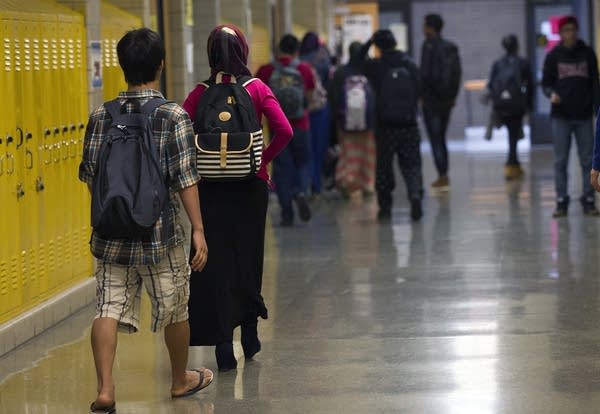Emergency school aid may only be Band-Aid for long-term funding gaps

Go Deeper.
Create an account or log in to save stories.
Like this?
Thanks for liking this story! We have added it to a list of your favorite stories.
Gov. Mark Dayton's call for emergency school funding would be a welcome boost for districts facing budget shortfalls and layoffs.
But school officials say it wouldn't address the long-term funding challenges driving the unusually high number of districts with budget deficits this year.
Dayton proposed spending $138 million on a one-time bump in school funding in the coming year. That would amount to an additional $126 for every Minnesota student.

"Is it temporary? Yes, because it's one-time funding," said Scott Croonquist, executive director of the Association of Metropolitan School Districts. "But it would certainly provide some relief and help mitigate some of the cuts and layoffs that school districts are looking at."
Turn Up Your Support
MPR News helps you turn down the noise and build shared understanding. Turn up your support for this public resource and keep trusted journalism accessible to all.
A survey by the association found 26 metro area districts are facing deficits and possible staff reductions and cuts to programs. Croonquist said that's higher than any school year since 2011-12.
The factors driving the budget shortfalls vary by district, but there are some common themes. State education aid hasn't kept pace with rising costs and inflation. School districts are having to cover a growing gap between their special education costs and what they receive in state and federal funding.
Some districts also are seeing enrollment declines due to changing demographics, or students choosing open enrollment or charter schools, Croonquist said.
"When you combine the underfunding of special education with declining enrollment, you really create a very difficult situation for school districts," he said. "That's why we see some very big shortfalls in some of those districts."
That's happening in Fridley, where growing enrollment had largely spared the school district from budget cuts. Now, enrollment is projected to go down slightly, and the district is having to "right size," said finance director Matthew Hammer.
The district is looking at cutting about $1.2 million, including laying off about 20 teachers and support staff, Hammer said. Because of the enrollment decline, class sizes shouldn't grow, he said.
Under Dayton's proposal for a one-time 2 percent increase in funding, Fridley would get an additional $350,000 to $400,000, which equals about five staff positions.
"Obviously, any funding would be positive," Hammer said. However, if it's just a one-time boost, the district would need to figure out how to make up the difference the following year, he said.
In Mahtomedi, the district is faced with cutting about $1 million from its budget, said Bill Menozzi, director of business services.
Like most districts, the majority of Mahtomedi's budget is spent on salaries and benefits. That makes it difficult to cut costs without reducing staff, Menozzi said.
"When 80 cents on the dollar is spent on personnel, there's only so much you can cut that's outside of the classroom," he said.
Schools in outstate Minnesota are facing similar struggles. Most rural school districts depend heavily on the state education funding formula because they don't have an operating referendum like many metro districts.
That has created a nearly $700 per student difference between metro and rural districts, said Fred Nolan, executive director of the Minnesota Rural Education Association. He said the 2 percent increases in state aid in the last two years have been barely keeping up with inflation.
Nolan said several small districts are looking at cutting two or three staff. That doesn't sound like much, he said, but can make a big difference in a district with just 1,000 students.
The governor's proposed funding would help those districts by not having to cut quite so much, Nolan said.
"Anything to forestall an impact on students is helpful," he said.

Republican state legislators have said the school funding situation isn't an emergency, and schools need a long-term solution to their perennial budget problems.
"It's a Band-Aid approach," Rep. Jenifer Loon, R-Eden Prairie, chair of the House Education Finance Committee, said on MPR News' Morning Edition. "It may help a few districts get through the year, but many reports I've seen of schools welcoming the additional money have said they're still going to move forward with cuts."
Charlene Briner, deputy commissioner of the Minnesota Department of Education, acknowledges the funding won't eliminate all of the budget reductions. But she said the extra dollars could help staunch the worst cuts to preserve class sizes or avoid cutting programs.
"I think that it also puts pressure to bear on policymakers in the next legislative session and whoever the governor will be to really look at the systemic structural funding challenges that schools are facing," Briner said.


